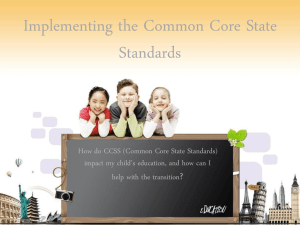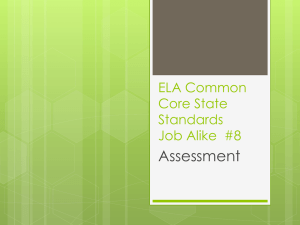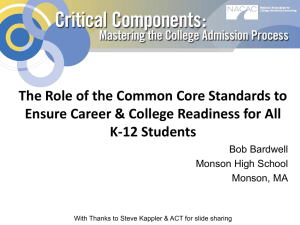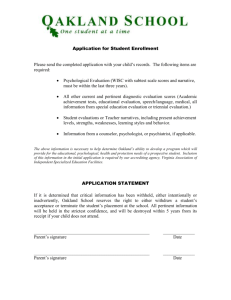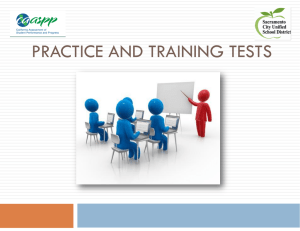November 2011 - Oakland Schools
advertisement
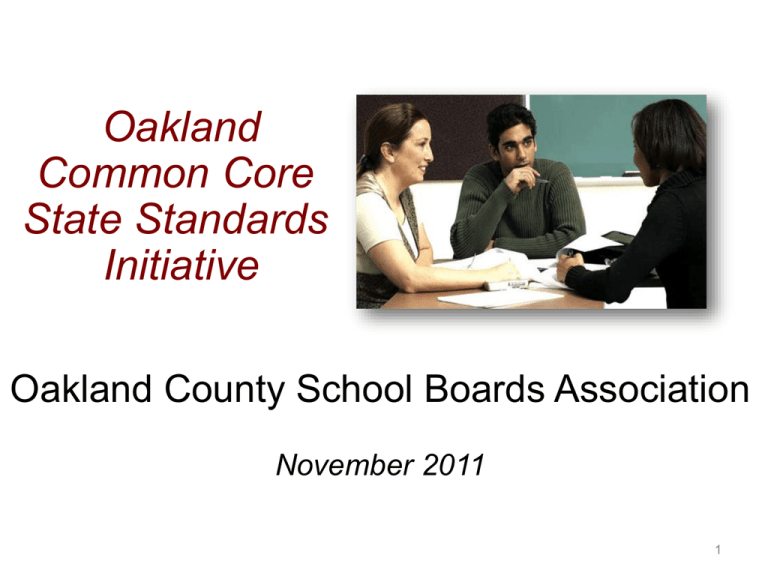
Oakland Common Core State Standards Initiative Oakland County School Boards Association November 2011 1 Session Goals • To briefly explore the Common Core State Standards and related assessments • To understand the Oakland Common Core State Standards Initiative and its implications 2 Common Core State Standards http://www.corestandards.org/ 3 Common Core State Standards • The development of the Common Core State Standards for Mathematics and English Language Arts was lead by – National Governor Association – Council of Chief State School Officers • The Standards focus on learning expectations for students, not on how students get there 4 Common Core Standards • Why Now? – Disparate standards across states – Student mobility – Global competition – Today’s jobs require different skills 5 Common Core State Standards 6 Common Core Standards • Criteria for the K-12 standards – Fewer, clearer and higher – Aligned with college and work expectations – Include rigorous content and application of knowledge through high-order skills – Build upon strengths and lessons learned from current state standards – Internationally benchmarked – Based on evidence and research 7 ELA Standards – Greater focus on informational reading and writing • 70% of time in high school Strong emphasis on deep comprehension of rich literature and content area expository text Include separate Standards for Literacy in History/Social Studies and Science classes for grades 6-12 8 Mathematics Standards – Standards for Content – Standards for Practice Greater balance of concept and skill development New focus on • Mathematical Modeling • Problem Solving • Reasoning 9 Standards for Mathematical Practice Reasoning and explaining Modeling and Using tools Seeing structure and generalizing William McCallum, Standards for Mathematical Practice; Tucson, April 2011 10 Balanced Assessment Consortium 11 http://www.k12.wa.us/smarter/http://www.k12.wa.us/smarter/ Assessing the Common Core States Standards What we think we know… The SMARTER Balanced proposal suggests that there will be various assessments for grades 3-11 including: a) Comprehensive summative assessments that includes: • 22% selected-response • 41% technology-enhanced constructed-response • 14% traditional constructed response • 23% performance b) Formative assessments 12 Assessing the Common Core States Standards What we think we know… • • • • The new assessment will replace the MEAP and MME and be initiated at the end of the 2014-2015 school year. It will be designed to be taken online, but pencil and paper versions will be available for three years. Students may take the test twice and use their best scores In the future we will see the development of alternative standards/assessments for severely learning impaired and ELL students Sample Mathematics Task Sample Mathematics Task Sample ELA Task 16 Common Standards and Assessments • Common standards and assessments are essential but inadequate by themselves • To be successful, educators also need – Curriculum, including units of study, based on the standards – Instructional materials that align with the standards – A variety of assessments to measure student progress – Resources, tools and time to adjust classroom practices 17 Common Core State Standards Initiative Oakland The Common Core State Standards Initiative (CCSSI) Oakland provide support and direction for educators as they move toward full implementation: CCSS aligned curriculum and coherent units of study to highlight needed shifts in content related and pedagogical practices – Highlight Lessons – Formative Assessment – Resources (video, sample student work, rubrics, instructional websites, etc.) Will be used different ways by different districts 18 Oakland CCSS Initiative Benefits include: Saving districts the time and money associated with designing their own curriculum Sharing and building on county-wide expertise Increasing teacher collaboration through co-construction and electronic sharing of lesson plans and instructional strategies Promoting a focus on high quality classroom instruction aligned to a coherent curriculum Creation of opportunities for additional time and money saving collaborations such as large purchases, and common professional development 19 Oakland CCSS Initiative National Projects Steering Committee And Leadership Teams CCSS Curriculum Writing Teams Pilot and Review Teams 20 DOMINO EFFECT Year 1 One unit of study per grade (K-12) for both ELA and Math Year 2 Four additional units of study per grade (K12) for both ELA and Math Proposed process for development of K-12 curriculum aligned to Common Core State Standards for both ELA and Mathematics Year 3 Full K-12 curriculum for both ELA and Math aligned to CCSS K-12 Unit Development • 2010-2011 – One unit per grade level developed in Mathematics and ELA • 2011-2012 – Professional development to support district leadership development and classroom implementation of one unit – Four units developed in both content areas • 2012-2013 – Professional development to support district leadership development and classroom implementation of four units – Three units developed in both content areas • 2013-2014 – Professional development to support district leadership development and classroom implementation of three units Full Implementation in 2013-2014 ! 2011 – 2012 Implementation The first set of units developed and implemented focus on content trajectories identified by our CCSS Mathematics Leadership Team Grades K-5 6-8 9 - 11 Focus Place Value Ratio, Rate and Slope Transformations (function & shape) 23 2010 – 2011 Phase I ELA 24 Phase 1: Academic Writing Units Developed K-12 K 1st 2nd 3rd 4th 5th 6th 7th 8th 9th 10th 11th 12th Opinion Letter: About a book Opinion Letter: Around a Social Issue Opinion Review Personal Essay: Generating and Supporting a Thesis Personal Essay: Exploring Types of Evidence Personal Essay: Determining Relevant and Logical Reasoning Developing Voice to Address Public Concern Complaint Letter Seeing local struggles and developing solutions Proposal Essay Developing claim and counterclai m through issue-based Op/Ed Critical Review OpEd Essay Editorial Social Commentary Grade Level Unit Components 1. Unit Themes • • • • Graphic Focus Questions Intellectual Processes Key Concepts 2. Content Standards • • Abstract CCSS Standards 3. Instructional Resources • • • • • Lesson(s) Assessments Exemplars Children’s Literature Websites 4. Professional Resources • • Articles Books 25 Atlas Curriculum Mapping Units, Highlight Lessons, Highlight Assessments and other resources available in Atlas by Rubicon Public Site: http://oaklandk12.rubiconatlas.org/public 26 Online CCSS Curriculum Resources Units of Study Lesson resources Assessment resources Professional resources • Video • Sample student work • And more 27 Oakland CCSS Initiative NATIONAL Smarter Balanced Consortium Professional Organizations COUNTY Avondale Berkley Birmingham Bloomfield Hills Brandon Clarenceville Clarkston Clawson Farmington Ferndale Hazel Park Holly Huron Valley Lake Orion Lamphere MAISA STATE Madison Novi OS Oak Park Oakland Schools Oxford Pontiac Rochester Royal Oak South Lyon Southfield Troy Walled Lake Waterford West Bloomfield • MAISA Mathematics and ELA Leadership Teams 28 CCSS Latest News and Resources http://tinyurl.com/Oakland-Schools-CCSSResources Session Goals • To briefly explore the Common Core State Standards and related assessments • To understand the Oakland Common Core State Standards Initiative and its implications 30 Oakland Schools Common Core State Standards Initiative Questions about tonight’s presentation? Contact us at: Valerie.Mills@oakland.k12.mi.us Joan.Firestone@oakland.k12.mi.us

